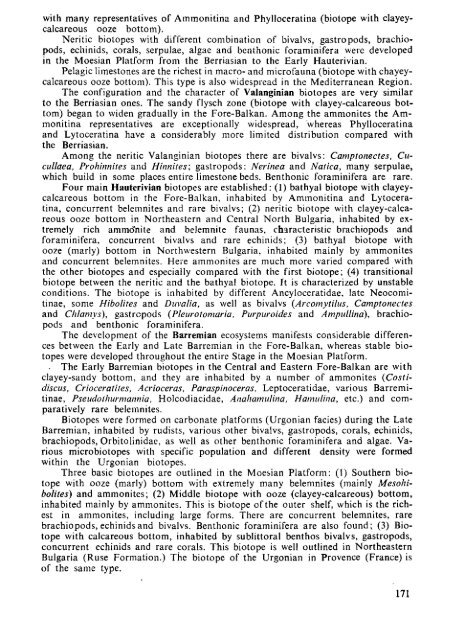THE MEDITERRANEAN LOWER CRETACEOUS
THE MEDITERRANEAN LOWER CRETACEOUS
THE MEDITERRANEAN LOWER CRETACEOUS
You also want an ePaper? Increase the reach of your titles
YUMPU automatically turns print PDFs into web optimized ePapers that Google loves.
with many representatives of Ammonitina and Phylloceratina (biotope with clayeycalcareous<br />
ooze bottom).<br />
Neritic biotopes with different combination of bivalvs, gastropods, brachiopods,<br />
echinids, corals, serpulae, algae and benthonic foraminifera were developed<br />
in the Moesian Platform from the Berriasian to the Early Hauterivian.<br />
Pelagic limestones are the richest in macro- and microfauna (biotope with chayeycalcareous<br />
ooze bottom). This type is also widespread in the Mediterranean Region.<br />
The configuration and the character of Valanginian biotopes are very similar<br />
to the Berriasian ones. The sandy flysch zone (biotope with clayey-calcareous bottom)<br />
began to widen gradually in the Fore-Balkan. Among the ammonites the Ammonitina<br />
representatives are exceptionally widespread, whereas Phylloceratina<br />
and Lytoceratina have a considerably more limited distribution compared with<br />
the Berriasian.<br />
Among the neritic Valanginian biotopes there are bivalvs: Camptonectes, Cucullaea,<br />
Prohinnites and Hinnites; gastropods: Nerinea and Natica, many serpulae,<br />
which build in some places entire limestone beds. Benthonic foraminifera are rare.<br />
Four main Hauterivian biotopes are established : (1) bathyal biotope with clayeycalcareous<br />
bottom in the Fore-Balkan, inhabited by Ammonitina and Lytoceratina,<br />
concurrent belemnites and rare bivalvs; (2) neritic biotope with clayey-calcareous<br />
ooze bottom in Northeastern and Central North Bulgaria, inhabited by extremely<br />
rich ammonite and belemnite faunas, characteristic brachiopods and<br />
foraminifera, concurrent bivalvs and rare echinids; (3) bathyal biotope with<br />
ooze (marly) bottom in Northwestern Bulgaria, inhabited mainly by ammonites<br />
and concurrent belemnites. Here ammonites are much more varied compared with<br />
the other biotopes and especially compared with the first biotope; (4) transitional<br />
biotope between the neritic and the bathyal biotope. ft is characterized by unstable<br />
conditions. The biotope is inhabited by different Ancyloceratidae, late Neocomitinae,<br />
some Hibolites and Duvalia, as well as bivalvs (Arcomytilus, Camptonectes<br />
and Chlamys), gastropods (Pleurotomaria, Purpuroides and Ampullina), brachiopods<br />
and benthonic foraminifera.<br />
The development of the Barremian ecosystems manifests considerable differences<br />
between the Early and Late Barremian in the Fore-Balkan, whereas stable biotopes<br />
were developed throughout the entire Stage in the Moesian Platform.<br />
The Early Barremian biotopes in the Central and Eastern Fore-Balkan are with<br />
clayey-sandy bottom, and they are inhabited by a number of ammonites (Costidiscus,<br />
Crioceratites, Acrioceras, Paraspinoceras, Leptoceratidae, various Barremitinae,<br />
Pseudothurmannia, Holcodiacidae, Anahamulina, Hamulina, etc.) and comparatively<br />
rare belemnites.<br />
Biotopes were formed on carbonate platforms (Urgonian facies) during the Late<br />
Barremian, inhabited by rudists, various other bivalvs, gastropods, corals, echinids,<br />
brachiopods, Orbitolinidae, as well as other benthonic foraminifera and algae. Various<br />
microbiotopes with specific population and different density were formed<br />
within the Urgonian biotopes.<br />
Three basic biotopes are outlined in the Moesian Platform: (1) Southern biotope<br />
with ooze (marly) bottom with extremely many belemnites (mainly Mesohibolites)<br />
and ammonites; (2) Middle biotope with ooze (clayey-calcareous) bottom,<br />
inhabited mainly by ammonites. This is biotope of the outer shelf, which is the richest<br />
in ammonites, including large forms. There are concurrent belemnites, rare<br />
brachiopods, echinids and bivalvs. Benthonic foraminifera are also found; (3) Biotope<br />
with calcareous bottom, inhabited by sublittoral benthos bivalvs, gastropods,<br />
concurrent echinids and rare corals. This biotope is well outlined in Northeastern<br />
Bulgaria (Ruse Formation.) The biotope of the Urgonian in Provence (France) is<br />
of the same type.<br />
171

















